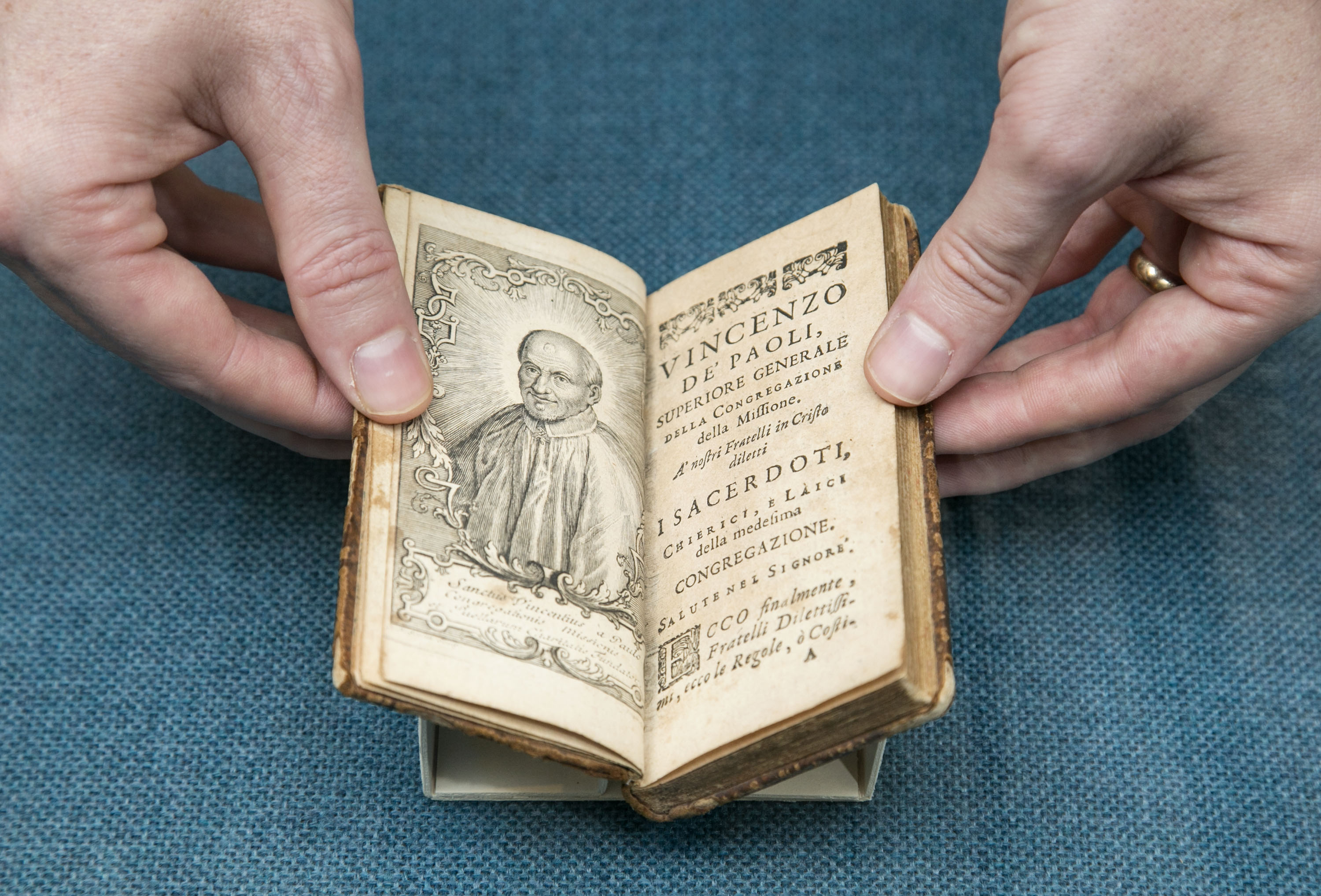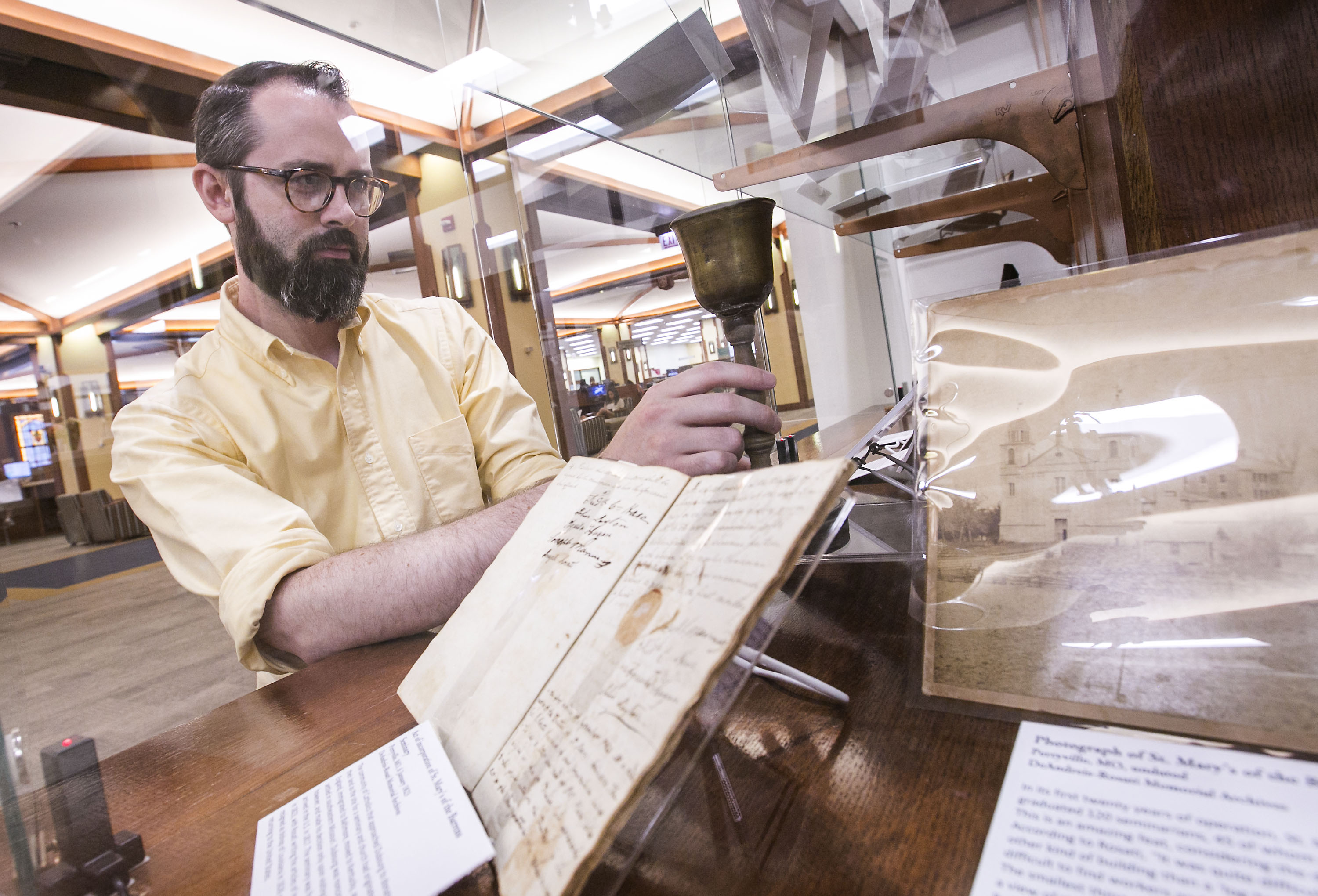 After Vincent de Paul founded his Congregation of the Mission in 1625, he codified rules by which the community was governed and directed. These rules were eventually printed in 1658, two years prior to Vincent’s death, and distributed amongst his colleagues. This pocket-sized copy, which is in Italian, will be on display at the exhibition. (DePaul University/Jamie Moncrief)
After Vincent de Paul founded his Congregation of the Mission in 1625, he codified rules by which the community was governed and directed. These rules were eventually printed in 1658, two years prior to Vincent’s death, and distributed amongst his colleagues. This pocket-sized copy, which is in Italian, will be on display at the exhibition. (DePaul University/Jamie Moncrief)
CHICAGO — This year,
the Congregation of the Mission — Vincentian priests — will be celebrating their
200th anniversary in America and the Richardson Library at DePaul University is
mounting a large exhibit to mark the milestone.
The exhibit titled “The
Bicentennial Celebration of the Vincentians in America,” is co-sponsored
by DePaul’s Office of Mission and Values and will feature more than 50 objects
in two separate displays.
The first presentation, “God as Compass, Rudder, and Pilot: The Missionary as a Pioneer,”
details the journey of the Vincentian missionaries, from their start in Rome in
1815 to the their eventual settlement at St. Mary’s of the Barrens in the
Missouri Territory in 1818.
Its sister display, “Knowledge
and Salvation: The Missionary as a Man of the Enlightenment,” explores
books in the Richardson Library Collection from the first American Vincentians
and the influence of the Enlightenment — an intellectual movement in Europe
during the late 17th and 18th centuries emphasizing reason and individualism
rather than tradition — on the missionaries.
“There really is a mix of materials that make up both parts of
the exhibit. Many of the items are manuscript letters and documents, meaning
that they are literally one-of-a-kind documents written by the missionaries themselves,”
said Vincentian Librarian Andrew Rea.
 Andrew Rea, DePaul's Vincentian Librarian, places a small wooden chalice into a display case as he prepares for an exhibit of Vincentian artifacts at the John T. Richardson Library. (DePaul University/Jamie Moncrief)
Andrew Rea, DePaul's Vincentian Librarian, places a small wooden chalice into a display case as he prepares for an exhibit of Vincentian artifacts at the John T. Richardson Library. (DePaul University/Jamie Moncrief)“
The items on display speak to the Vincentian purpose of the
American mission, and to the Vincentian values of charity, humility, zeal and
simplicity,” said Rea. “They also reflect the values of the missionaries
themselves, which informed how the American province has historically been run
and how it differed from the provinces in Europe.”
Priests making
American history
The exhibition will feature artifacts, letters, documents, maps
and books that were either owned by Vincentians and part of their first
library, or are significant to the journey and experience of those first
American Vincentians, noted Rea. The majority of materials on display are held
in DePaul University Special Collections and Archives as part of the Vincentian
Studies Collection, but items from the St. Louis Archdiocesan Archives and the
Vincentian Curia Archives in Rome are also featured.
“While the exhibit acknowledges the religious vocations and
motivations of the Vincentian missionaries, we are hoping to cast the priests
in a light beyond their role as men of the cloth and placing them into the larger
arena of American history,” said Rea.
According to an essay written by the Rev. John Rybolt, C.M.,
in conjunction with the exhibition, the Vincentians opened six seminaries in
America in the mid-1800s. In addition to opening seminaries and schools in
America, Vincentians staffed parishes as administrative units. A sustained
focus on missions in the United States developed in the early 20th century as
many parishes began requesting them.
Although Vincentian priests were expected to provide these
travelling missions, it entailed debilitating work. Difficult travel,
undeveloped infrastructure and primitive accommodations, days and nights spent
preaching, teaching and hearing confessions, and visiting the sick and elderly
was a ministry best suited to the young and healthy, Rybolt wrote.
Following Vincent’s
model
The leading principle of the Vincentians has been to
incarnate Vincent de Paul’s spirit, or “charism,” in the parishes they set up,
explained Rybolt, DePaul Vincentian Scholar-in-Residence. Vincent’s concern for
the poor and marginalized is the religious and pastoral key to Vincentian lives
today.
The same perspective has grown in Vincentian universities,
such as DePaul which was founded in 1898. Known for their diversity in faculty
and student body, Vincentian universities strive to encourage and welcome first
generation college students to work for undergraduate and graduate education,
and reach out to those unable to afford higher education, Rybolt detailed in
his essay. Vincentians understand education as a major route out of poverty,
and they endeavor to make Vincent de Paul alive in all the members of the
university communities.
An opening reception will be held Sept. 28 from 4-6 p.m. in
Special Collections and Archives in the Richardson Library, 2350 N. Kenmore
Ave., on DePaul’s Lincoln Park Campus. The opening will feature remarks from Rea
and the Rev. Dennis H. Holtschneider, C.M., president of DePaul University. The
free exhibition will be open to the public through March 2017.
###
Source:
Andrew Rea
Area1@depaul.edu
775-325-8117
Media contact:
Jon Cecero
JCecero@depaul.edu
312-362-7640